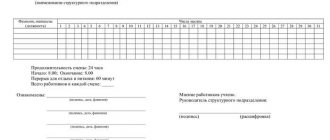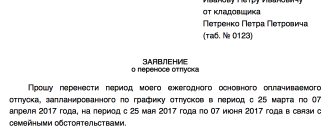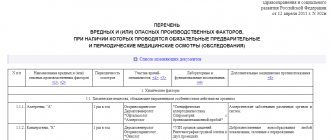How much, in what mode and according to what schedule employees work, each employer decides independently. The main condition is that working hours do not exceed the thresholds established by law. As a rule, the operating mode is set once and for a fairly long period of time, but sometimes, due to various circumstances, there may be a need to change it. The main document on the basis of which changes occur is the order to change the working hours.
- Form and sample
- Free download
- Online viewing
- Expert tested
FILES
How and where the operating mode is reflected
Documents that record employees' working hours:
- collective or individual labor agreement,
- internal labor regulations.
Moreover, if there is a trade union organization at the enterprise, its opinion must be taken into account when establishing the working regime.
If any changes are made to this parameter of working conditions, the company must draw up a corresponding order, also approved by the trade union. The absence of this document, if anything happens, can lead to administrative punishment from supervisory authorities in the form of a fairly large fine both for the enterprise itself and for its manager.
What documents reflect the work regime in the organization?
A company may have a uniform working time schedule for all personnel, or an individual work schedule for a number of subordinates or even one employee.
The working time regime is the procedure for delimiting the working time of employed people within a certain period of time.
The selected period can be expressed:
- working day or week;
- month;
- over a longer period of time.
Lawmakers established the following types of working hours:
- normal mode (single shift);
- irregular working hours;
- flexible working hours;
- shift work schedule;
- shift work method;
- working hours divided into parts.
Which mode of operation the employer prefers depends on the goals he sets for himself, as well as on the scope of the organization’s activities.
Working hours are reflected in the following documents of the organization:
- collective agreement (if there is one);
- employment contracts;
- internal labor regulations (hereinafter referred to as PVTR).
The need to fix the labor regime in a collective agreement arises if the procedure is common to all workers.
A collective agreement is a document regulating labor relations between an employer and subordinates, taking into account the opinions of representatives of these parties.
If an employer establishes the same working hours for all its employees, the work schedule is fixed in the collective agreement
The work schedule is reflected in the employment contract if the work schedule of a particular employee differs from the general labor rules in the organization.
An employment contract is an agreement valid between an employer and an employee, which establishes the rights and obligations of the parties, and also introduces liability for their violation.
The work schedule of a specific employee is reflected in the employment contract if it differs from the work schedule of other employees
Internal labor regulations are a regulatory act developed by the responsible persons of the company, in accordance with which the employment and dismissal of personnel is carried out. On the basis of this document, compliance with labor discipline rules is monitored.
PVTR are approved by management, taking into account the opinion of the representative body interested in respecting the rights of workers.
PVTR and employment contracts must provide for:
- duration of daily work;
- the time when the subordinate must begin to perform his professional duties;
- the time when the employee has the right to complete his work;
- availability of a lunch break and its duration;
- the opportunity to take an additional break for rest;
- number of shifts per day;
- alternation of working and non-working days;
- work with irregular working hours for certain categories of workers.
The internal labor regulations record all the nuances of the work process of the organization’s employees.
Who draws up the order
An order to change the working hours is drawn up on behalf of the director of the enterprise by any employee authorized to write administrative documentation. This could be the head of a structural unit, secretary, legal adviser, etc.
The completed order is submitted to the head of the company for approval.
Without his signature, it will not acquire legal force and can be challenged without much difficulty with the help of a court or labor inspectorate.
Who makes the decision?
The decision on all changes, including working hours, is made by the manager. This is within his competence.
But there are two important points here.
If we are talking about introducing new conditions into an employment contract, then a written agreement with the employee is required (Article 72 of the Labor Code). Well, the procedure for adopting the PVTR, according to Art. 190 of the Labor Code, requires agreement on new working hours with the trade union or other employee representatives.
A sole decision of the manager made in violation of these requirements will become a reason for a labor dispute.
What is part-time work? Is consent required for employment by transfer? See here.
What to rely on when creating an order
All orders issued by companies must have some basis in the form of a written document or legal norm. In this case, article 74 of the Labor Code of the Russian Federation can be indicated as such, the provisions of which serve as a direct basis for writing orders of this kind, but only on the condition that the changes are caused by changes in technical characteristics or organization of working conditions.
By referring to this article of the law, the employer can change the working hours without being interested in the opinions of subordinates.
But Article 72 of the Labor Code of the Russian Federation, which can also serve as the basis for issuing an order to change the working hours, can only be referred to if these changes occurred by mutual agreement of the parties .
What is a working time schedule and working hours?
It’s worth starting with the fact that the organization’s work schedule and the employee’s work schedule are different concepts.
A work schedule is the distribution of working time and rest time for employees during a certain calendar period. A document under this name is developed by management for the purpose of planning the activities of employees and keeping records of the time they worked. Its contents are brought to the attention of staff one month before the schedule comes into effect. Ignoring the provisions of the document is fraught with trouble for employees.
Working hours may vary - options are presented in Art. 100 Labor Code of the Russian Federation. It should be noted that each employer has the right to determine specific working hours for its employees.
Most often, employees work five-day shifts: they have to devote to work 5 days a week, 8 hours a day. At the same time, they are given 2 days off for rest. Another common option is a six-day period. It assumes 6 working days a week and 1 day off. At the same time, the normal length of working time, just as with a five-day week, is no more than 40 hours per week (Article 91 of the Labor Code of the Russian Federation). When talking about the work schedule at an enterprise, in most cases it means shift work.
Key points in drafting an order
Now there is no standard, uniform sample order for changing working hours, so employers can write it in any form. In some cases, enterprises use internal document templates approved in the company's accounting policies. But, regardless of which path is chosen, the order must include a number of mandatory information. These include:
- Document Number,
- locality,
- date of document preparation,
- Name of the organization,
- the essence of the order, i.e. new working hours,
- the basis for its writing,
- persons responsible for its execution, indicating their positions and full names (here this is usually a specialist or the head of the personnel department).
It would be good if the reasons why these changes occurred were immediately indicated (optimization of the production process, difficult financial situation of the company or, on the contrary, an increase in the volume of work, etc.). If any additional papers are attached to the document, their presence must be indicated in a separate paragraph.
It must be said that the order may concern both individual employees of the enterprise and the entire team as a whole: information about this also needs to be reflected in the document.
Important points related to possible legal and administrative risks
- When drawing up a notice, it is necessary to take into account whether the legislator allows the given employee to offer new conditions.
For example, underage employees, disabled people and women with children under 3 years old are not allowed to work on night shifts. In a court - A notification procedure can be carried out in relation to a pregnant employee, but if she refuses, dismissal will be illegal. It is possible only in a situation of complete liquidation of a legal entity.
- When changing employee schedules, it is necessary to take into account the results of workplace certification. If an employee works in dangerous or harmful working conditions, you need to remember about the working time limits for cumulative accounting. It is important to calculate the maximum possible number of working hours in the new schedule.
- A list of factors that may cause changes can be found on the Rostrud website. Insufficient grounds will be assessed by control authorities as a hidden intention to reduce staff. A similar repeated violation will make it possible to disqualify the director of the company, prohibiting him from holding leadership positions for up to 3 years.
- The activities of some enterprises are regulated not only by federal legislation, but also by regional inter-industry agreements. They stipulate social and labor relations and additional guarantees for employees. You can request a list of existing agreements in your industry from your regional government.
Changing your work schedule unilaterally is a complex process. Strict adherence to the described rules will maintain the reputation of a law-abiding employer, reduce stress for employees and help avoid high penalties.
Top
Write your question in the form below
How to place an order correctly
As for the descriptive part of the document, the law does not impose any special requirements for its execution, so the order can be written on an ordinary blank sheet of A4 or A5 format or on company letterhead, printed or handwritten. The only thing that must be observed is the presence of an original signature of the head of the organization or a person authorized to endorse such papers.
In addition, the order is usually signed by the employees responsible for its implementation and those personnel representatives who are directly affected by it.
The signatures of the latter, although they do not have to be present on the document, indicate that their authors are familiar with the order and agree with it.
Today there is no strict need to put a stamp on an order: various types of cliches and stamps can only be used in cases where this norm is established in the internal local acts of the company. In the general procedure, which also applies to legal entities, seals and stamps are no longer required for use.
Usually the order is written in one original copy , additional copies can be made (for example, for presentation to the personnel department and accounting department).
Changing the work schedule at the initiative of the employer
Application for change of work schedule: sample
Sometimes it becomes necessary to change the work schedule of employees in one department or the entire enterprise. For example, production is switching to round-the-clock operation, and new shifts need to be introduced, or some employees need to be transferred to work in three days. Naturally, some workers may not like such conditions, and it is necessary to correctly draw up documents on transfer to a new schedule or dismissal in order to avoid mutual claims.
According to the Labor Code of the Russian Federation, the employer is obliged to notify employees of changes in the work schedule at least 2 months in advance. You can issue a collective notification and familiarize employees with it against signature, or send out personal notifications to each employee indicating their new schedule. If someone refuses to sign the notification, a report is drawn up about this.
Personal notices are drawn up in two copies, and on what remains with the employer, a receipt mark must be placed with the employee’s signature. This precaution avoids claims that employees were not notified of a transfer to a new schedule in a timely manner.
In any case, the employer does not have the right to force employees to work according to a new schedule. It is necessary to involve representatives of the trade union in its development, if there is one at the enterprise. All changes to labor regulations must be agreed upon with the head of the trade union or other body representing the interests of workers in the organization.
The employer issues an order to transfer to a new schedule. If the employee agrees, he either signs the order confirming his consent, or writes a statement addressed to management. After this, an additional agreement with a new schedule is drawn up in two copies: one remains for the employer, the second for the employee.
Changing the work schedule at the request of the employee
For one reason or another, a subordinate may need to change his work schedule. To do this, he can contact his boss with a request in the form of a statement. It confirms the voluntary expression of the worker’s will to have his working hours changed. In case of disagreement, this document will serve as proof that management has formalized the procedure without violations.
After considering the application, the employer makes a decision and responds with consent or refusal.
The most common reasons for changing the schedule are:
- change of place of residence, which means the employee has to spend more time getting to work;
- illness of a relative who needs daily care, etc.
Most often, what matters to an employer is not the time a person is present at the workplace, but his labor productivity. Therefore, if the employee can fulfill the norm set for him in a shorter time, the boss's answer will most likely be positive.
Alternatively, the boss can offer the employee a flexible work schedule (Article 102 of the Labor Code of the Russian Federation), which for some citizens can be very convenient. With a flexible schedule, the shift should not exceed 10 hours. In exceptional cases, its duration can be up to 12 hours.
In order for the employer to allow the subordinate to work under new conditions, the employee draws up a free-form application to change the work schedule.
A cap
The document header states:
- FULL NAME. and the position of the head of the organization;
- Company name;
- FULL NAME. and employee position.
Document text
The type of document is indicated: “Application”.
What follows is a text with a request. The wording may sound like this: “I ask you to change my working hours” and the previous and necessary modes are indicated. For example, an employee requests a 5-day work week of 40 hours to be replaced by an incomplete 5-day week with a total work time of 30 hours, with the working day reduced to 6 hours. It is also necessary to state the reason for changing operating hours. You can write briefly: “For family reasons” and the like. It is worth indicating in the application the date from which the subordinate plans to work according to the new schedule. You will also have to indicate the nature of the regime change - temporary or permanent. If the change is temporary, a period is indicated.
Under the text of the application, the employee puts a personal signature with a transcript and enters the date of completion.
If the boss is not against the changes, the application is endorsed and sent to the personnel department and accounting department. After this, an additional agreement is drawn up with the employee indicating the new working hours.










